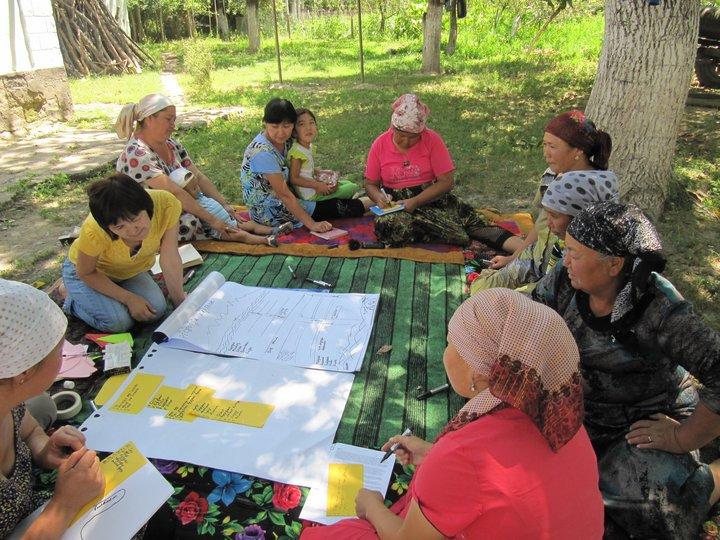How gender-specific knowledge is inspiring change in Kyrgyzstan’s walnut forests

Knowledge that can contribute to sustainable biodiversity management and conservation can differ between men and women within a community. Find out how taking a participatory research approach to gather that knowledge is proving fruitful.
This year for International Women's Day, Bioversity has collected stories that inspire progress. This blog post describes how gender-specific knowledge is inspiring change and progress in Kyrgyzstan’s walnut forests. Knowledge that can contribute to sustainable biodiversity management and conservation can differ between men and women within a community. Find out how taking a participatory research approach to gather that knowledge is proving to be fruitful in the walnut forests of Kyrgyzstan.
Kyrgyzstan is home to the largest walnut forests in the world: a 643,600 hectare haven of wild fruit tree biodiversity. These forests harbour a great diversity—both within and across species of trees and shrubs—that can serve as material for the breeding and development of new varieties of fruit crops in Central Asia.
While research has focused on the genetic potential of these forests, little is known about the different ways that women and men access, use and manage these forests and the differences in their knowledge about indigenous fruit tree biodiversity. To try and address this, gender-responsive participatory research was carried out in the villages of Kara-Alma and Jalgyz-Jangak, located directly within the forest and on the forest periphery, respectively.
In focus groups, participants were separated according to gender and age, which gave the different groups an opportunity to openly discuss their experiences, perceptions and preferences. Subsequent interviews took place privately and separately with women and men. It quickly became evident that gender, age and socio-economic features affect women’s and men’s access to forest resources and their knowledge of walnut forests.
For example, in Kyrgyzstan, forest land is owned by the government and managed by public forestry enterprises called ‘leskhozes’ that lease this land to local forest dwellers. Young women and men lamented about having very limited access to these forest areas. Such lands are mainly held by older men, who are culturally considered the head of the household. The limited forest area available for rent, coupled with rising population density and high reliance on non-timber forest products as one of the only local sources of income, is putting high demand on the walnut forests.
Young women described having difficulty acquiring information and taking part in meetings on the distribution of forest lands organized by the public forestry enterprise authority or community authorities. They are burdened by heavy household chores and stereotypes associated with the status of 'kelin' (daughter-in-law) that does not allow them to participate equally in discussions concerning management and allocation of resources.
Yet women often hold significant knowledge that can contribute to sustainable biodiversity management and conservation. For instance, older women protect the forest by collecting the larvae of gypsy moths that afflict forest trees, and women of all ages discussed the traditional techniques they practice to improve the productivity of trees growing in their home gardens: including manure addition, irrigation, soil loosening, whitewashing, pruning, and treatments against pests and diseases.
Engaging women as well as men in the participatory research process brings this valuable gender-specific knowledge to light and validates it in the eyes of their community. It also provides both the women and men participants an opportunity to learn from each other and share their ideas and concerns.
In addition to involving women and men of different ages and backgrounds in research activities, it is necessary to develop approaches that involve women, young and old, in their community’s affairs and to foster conditions that allow their knowledge to be valued and applied to agroforestry, indigenous fruit tree conservation, and other spheres of daily life.
Gendered access to agricultural and forest biodiversity and associated benefits and differentiated priorities for these resources affect women’s and men’s resource management strategies. Embracing the diversity of people who have developed this biodiversity and the distinct and multiple ways they manage and use it is essential for understanding and conserving that diversity effectively.
Blog post authored by Elmira Kaparova (Kyrgyz National Agrarian University), Kanaat Musuraliev (Innovation Centre for Phytotechnologies of the Kyrgyz National Academy of Sciences, Kyrgyzstan, and Bioversity International Gender Research Fellow), Rinaat Dujsheev (Innovation Centre for Phytotechnologies of the Kyrgyz National Academy of Sciences) and Kayirkul Shalpykov (Innovation Centre for Phytotechnologies of the Kyrgyz National Academy of Sciences).
Photo: Women part of a participatory gender-responsive research focus group, Kyrgyzstan. Credit: National Academy of Sciences of the Kyrgyz Republic/K.Musuraliev
Bioversity’s Gender Research Fellowship Programme is funded by the CGIAR Research Program on Forests, Trees and Agroforestry.
